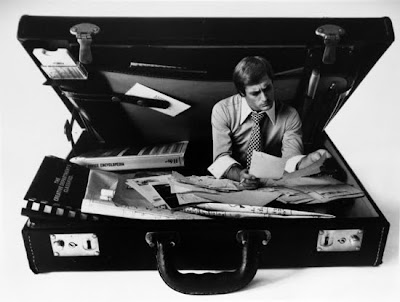
In an age when Photoshop seems to be a de facto part of nearly every photographer’s creative process, the ways of in-camera and darkroom trickery - montage, collage, double exposure, hand-retouching and re-photographing - are in danger of becoming a lost art. Alfred Gescheidt was a master of all these techniques and more, although his name has, rather unjustly, become largely unknown in recent years.
Once described by former New York Times photo editor John Durniak as “the Charlie Chaplin of the camera”, Geischeidt amassed a rich body of photographic work that was unique, satirical, idiosyncratic and at times even hallucinogenic.
Born and raised in New York City, at the age of nineteen Geischeidt was drafted into the Navy in 1945, towards the end of the World War II. After completing military service the following year he enrolled at the University of Mexico in Albuquerque on the GI Bill, where he was introduced to the work of Edward Weston, Henri Cartier-Bresson and Paul Strand, and decided photography was the career for him. He subsequently transferred to the Art Center School in Los Angeles where he studied under Will Connell and George Hoyningen-Huene, who introduced him to more experimental work and techniques, and it was here that he created some of his first photo collages.
After graduating, Gescheidt returned to New York and tried his hand at photojournalism - getting his work published in Life - but found it ultimately unfulfilling, so in 1955 he opened his own studio and focused on shooting advertising photography for leading agencies, and developing own style. Here he was able to use his education and imagination, and played around with all manner or experimental techniques to realize complicated and original photographs. His grasp of camera trickery and technical prowess left many of his fellow professional photographers baffled, and looking at some of the images here it’s not hard to see why. In the 50s and 60s, as the whole ‘Mad Men’ advertising agency era was booming, no one came close to Gescheidt for innovative photography, and he created numerous campaigns, magazine, book, and album covers. His images often both flattered and mocked American sensibilities, and his ’30 Ways To Stop Smoking’ series from 1964 remains a landmark in satirical conceptual photography.

Untitled (30 Ways To Stop Smoking), 1964


















Wonderful to see this stuff getting out into the world. I grew up with these images and just took them for granted. Thanks,
ReplyDeleteAndrew Gescheidt
My late father, Alfred Gescheidt, is without a doubt laughing from beyond the grave at his (our)last name spelled right half the time here, and the other half wrong. Welcome to the world of Gescheidt (spelled correctly). - Jack Gescheidt, www.JackPhoto.com
ReplyDeleteThis comment has been removed by the author.
ReplyDelete